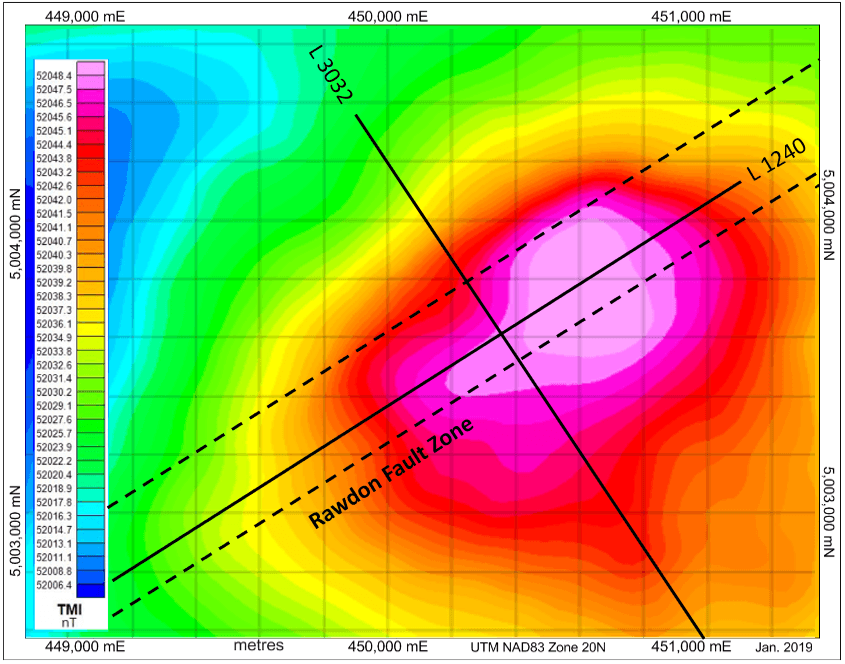Feb 8 2019
Generation Mining Limited has announced further results from the 2018 airborne VTEMTM survey performed on the western part of the Rawdon property located in Nova Scotia; in late 2018, 976 line kilometers of VTEMTM survey were flown in Nova Scotia.
 Plan views of color contoured Total field magnetic and EM VTEM data for the Rawdon West property, the interpreted location of the Rawdon Fault Zone (RFZ) and the location of the NE anomaly (inset enhanced). VTEM profiles L3032 and L1240 are also shown. (Image credit: Generation Mining Limited)
Plan views of color contoured Total field magnetic and EM VTEM data for the Rawdon West property, the interpreted location of the Rawdon Fault Zone (RFZ) and the location of the NE anomaly (inset enhanced). VTEM profiles L3032 and L1240 are also shown. (Image credit: Generation Mining Limited)
Through the VTEM survey, four conductive responses of primary interest were discovered, all of them close to the Rawdon Fault Zone (RFZ), which is assumed to have placed the prospective (for Cu, Pb, and Zn mineralization) lower units of the inconsistently conductive rocks of the Windsor Group in faulted contact with the basement rocks of the older and magnetic Meguma Super Group.
A wide database of the historic drill hole and ground/airborne geophysical data, such as magnetic, gravity, 2D seismic, and EM, support these discoveries, which are currently ready for drilling. The above image reveals the plan view of the site of a single discrete VTEM and magnetic anomaly on the property’s northeast side. The region of the conductive and magnetic is located along the RFZ’s surface trace. Additionally, the VTEM conductors of primary interest are located within the potential lower units of Windsor group rocks, coincident with a wider magnetic expression and discrete basement magnetic anomalies signifying near-surface proximity to the basement rocks.
A large geoscience database has been compiled by Generation Mining Limited for the Shubenacadie and Kennetcook-Windsor basins located in central Nova Scotia, with an aim to identify exploration properties permissive for the buildup of economic base metal deposits.
Historical geophysical and structural data were reinterpreted, which indicated that particular sites along the RFZ and related structures are prospective for Zn-Pb base metal deposits, which are structurally controlled. On the Rawdon West property, the RFZ is over 100 km long and around 1 km wide. A 40 km-section of the RFZ exists in the Rawdon West property, wherein the Lower Windsor Group evaporitic rocks, toward the north, have been structurally emplaced against the Fe-S-rich sandstones, shales, and slates of the Meguma rocks, toward the south. Between the two rock groups, a considerable vertical component of motion has been interpreted, leading to an additional faulting, upward folding, and brecciation of the lower Windsor rocks close to the RFZ and also in direct contact with the Meguma rocks. Generation Mining Limited anticipates that the structural deformation as well as uplifting of Lower Windsor Group rocks along the RFZ has promoted the migration of fluids rich in metals and produced a conducive environment for the buildup of economic base metal deposits.
On the Rawdon West property’s northern area, the VTEM survey has successfully identified a huge region (higher than 2.5 km X 1.5 km) of conductive, discrete source rocks, linked to an unexplored RFZ area, that are expected to be prospective for Zn-Pb deposits. A 6 km section of the historic 2D seismic profile (WND-007) intersects the RFZ close to this area of interest. To the southeast area, the layered Horton Group sediments superimpose the Meguma Basement, which is irregular, folded, and relatively older. It was observed that the south block of rocks lies in sharp structural contact with the south part of the sub-vertically oriented RFZ. Towards the northwest, the Lower Windsor Group lies in sharp contact with the RFZ’s north edge. Through a series of 15 historical ground gravity stations data obtained along a profile, which is directly above the magnetic anomaly, the presence of a dense source was confirmed at modeled depths consistent with that projected for the magnetic source at the same site.
The VTEM response at the RFZ’s north edge and coincident with the magnetic/gravity anomaly, denotes a zone of extremely low resistivity starting at a depth of about 200 m. The total magnetic intensity (TMI) profile distinctly revealed the presence of a magnetic contact to the west. Furthermore, the magnetic peak was observed to occur off center west of the estimated site of the VTEM anomaly source, imaged as the extremely low resistivity zone of about 1 km strike length, in the modeled VTEM section beneath the TMI profile. As a result, the responses may point to a location permissive to base metal mineralization starting at 200 m from the surface.
Within the Rawdon West property, Generation Mining Limited has also detected three other regions of exploration interest, and subject to financing, the company has planned a drilling operation later in 2019.
Within the Lower Windsor Group Rocks, significant deposits include the Walton Ba-Pb-Zn-Cu-Ag deposit (situated 20 km west of the Rawdon West property), which generated 4.3 million tons of barite together with 412,000 tons of sulfide mineralization grading 0.52% copper, 1.29% zinc, 4.28% lead, and 350 g/ton silver; the Gays River mine (situated 30 km southeast), which has an indicated and current measured resource of 12,205,000 tons grading 1.60% lead and 2.76% zinc in a number of deposits; and the Smithfield deposit (situated within the Rawdon East property on claims not owned by Generation Mining Limited), which yielded fleetingly in the 1880s and in the 1950s, reported a 500,000 ton deposit grading 2.7% lead and 3.5% zinc.